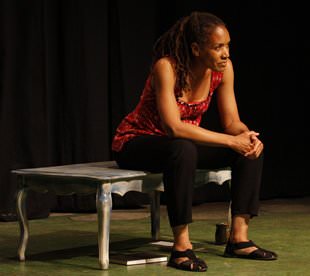If you like theatrical storytelling—the kind that catches you by the heartstrings, gets you all wrapped up, then doesn’t let loose until the very end—you’re going to love The Resurrection of Alice.

All alone on stage for all of two acts—all the while peopling it with upwards of a dozen distinct and delightful characters—Perri Gaffney brings to the Undercroft Theatre (in a Woman’s Works Program presentation of The Essential Theatre) such virtuosity and intimacy that all distance of time and place disappears and the story she tells all happens right here right now just for us.
And what a story it is. Told in a pastiche of rural South Carolina dialects, it begins in the 1940s and introduces us to a charming 15-year-old named Alice. Spirited and full of hope and life, she wins a full scholarship to go to college. But her promising future is dashed when her parents let her in on a binding deal they cut when she was seven with a Mr. Tucker, a much older man: As soon as Alice reached marriageable age, Mr. Tucker would get her as his wife. If he didn’t, all his years as a kindly background benefactor to the family (calculatedly making, in effect, down payments on her bride price) would stop cold, and her parents and sibs, all dependent on his quid pro quo dole, would be destitute.
As performed by Gaffney, the scene in which Alice learns of her fate, and realizes the cost to her family if she tries to escape it, is so painful to watch that one nearly wants to stand and interrupt this ceremony and have it called off right then and there—which is a measure of how artfully Gaffney’s consummate storytelling builds its ineluctable momentum.
The script was adapted by Gaffney from her novel of the same name. Because the play is promoted as being topical and educational and about arranged marriage—a scourge that I did not know continues in this country to this day—I had some qualms before attending. Would this show feel like a movie of the month about “an issue”? Would it get all message-y and instructional and have no dramatic heart and soul? Well, I could not have been more mistaken.
For a useful analogy, think of the difference between how the topic of another scourge, female genital mutilation, has been treated by Alice Walker (to whose The Color Purple Gaffney’s Resurrection of Alice bears a touching family resemblance). As a political activist, Walker has done important documentary work about FGM (Warrior Marks). But as a novelist, Walker has created a rich and character-driven novel (Possessing the Secret of Joy) in which FGM is a crucial factor in the plot but does not stick out like a sore polemic. That’s exactly what Gaffney has done with arranged marriage in her Resurrection of Alice: She has created an emotionally compelling story driven by captivating characters, one of whose fate turns on a practice that is indeed a topic—but if you come scoping for takeaway points you will have to find them deeply embedded in a beautifully told tale.
What first piqued my interest in the show was seeing this video, which records the beginning of the play when Alice is seven. If you watch, you’ll get a foretaste of Gaffney’s pace-perfect script, where there is not a superfluous syllable and every line of dialog propels the the narrative. You’ll also glimpse how astonishingly Gaffney’s switches from character to character.
Special mention must go to Sharri Lavie Crockett’s fluidly imaginative lighting and eloquent sound design. Yes, this was Gaffney’s tour de force solo performance, but I was wowed by how the lighting and sound seemed an omnipresent supporting cast.

The title already gives a lot away so I’ll not say more about this womanist parable’s amazing outcome except that the word “resurrection” could fairly be swapped out for “emancipation”—a moving theme foreshadowed when Alice names her first child Harriet…after Harriet Tubman.
I have to acknowledge I had one slight difficulty: In the quickly paced last ten minutes or so—when a stunning plot twist is revealed—I lost track of the story line, which suddenly was more rushed than I could follow, and I had to piece it together in my mind after I’d left the theater. That plot twist is a stunner—but it comes so unexpectedly (and yet in hindsight so plausibly) that I could have used a little “here’s what’s happening” assist from the extraordinary storyteller who till then had utterly tugged my heartstrings.
Running Time: One hour and 45 minutes, with one intermission.
The Resurrection of Alice plays through September 7, 2013 at The Essential Theatre at Undercroft Theatre – 900 Massachusetts Ave. NW, in Washington, DC. For tickets, purchase them online.




